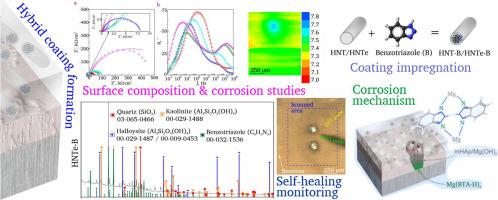用于镁合金主动防腐的高效智能复合涂层
IF 13.8
1区 材料科学
Q1 METALLURGY & METALLURGICAL ENGINEERING
引用次数: 0
摘要
本文讨论了克服目前临床实施Mg植入物的局限性的潜在解决方案,通过形成生物相容性的peo基抑制剂和聚合物混合涂层来控制生物可吸收材料的腐蚀降解。在MA8镁合金表面制备了多功能杂化涂层。以等离子体电解氧化法制备的多孔类陶瓷涂层为基础,采用含高岭土纳米管(HNTs)的生物可吸收聚合物(聚己内酯,PCL)和缓蚀剂(苯并三唑,BTA)进行改性。提出了用BTA浸渍HNT并将其引入PCL基体的方法。采用SEM-EDX、XRD、XPS和拉曼显微光谱分析了保护层的化学成分。通过电化学、失重和析氢试验等方法测定涂层试样的防腐防护水平。混合层样品在汉克斯平衡盐溶液中暴露23 h时的防腐效果最好(|Z|f = 0.1 Hz = 1.02 MΩ·cm2, IC = 11 nA·cm-2, Rp = 2.4 MΩ·cm2),在HBSS中暴露7天后的降解率最低(0.021 mm/年)。利用局域化电化学技术对涂层样品在微尺度上的电化学活性进行了评价。提出了杂化层试件的降解机理。展望了杂化层在调节镁合金吸收过程中的应用前景。本文章由计算机程序翻译,如有差异,请以英文原文为准。

Efficient and smart hybrid coatings for active corrosion protection of magnesium alloys
This article discusses potential solutions to overcome current limitations for clinical implementation of Mg implants by forming the biocompatible hybrid PEO-based inhibitor- and polymer-containing coatings for a controlled corrosion degradation of the bioresorbable material. Multifunctional hybrid coatings were obtained on MA8 magnesium alloy. The porous ceramic-like coating synthesized by plasma electrolytic oxidation served as a base for further modification with bioresorbable polymer (polycaprolactone, PCL) contained halloysite nanotubes (HNTs) with corrosion inhibitor (benzotriazole, BTA). The method for HNT impregnating with BTA and introducing them into the matrix of PCL was proposed. The chemical composition of the protective layers was studied using SEM-EDX, XRD, XPS, and Raman microspectroscopy. Anticorrosion protection level of the coated specimens was determined by means of electrochemical techniques, weight loss, and hydrogen evolution tests. The samples with hybrid layers showed the best corrosion protection during 23 h exposure to Hanks’ Balanced Salt Solution (|Z|f = 0.1 Hz = 1.02 MΩ·cm2, IC = 11 nA·cm–2, Rp = 2.4 MΩ·cm2) and the lowest degradation rate (0.021 mm/year) after 7 day of exposure to HBSS among all the tested samples. The electrochemical activity on microscale of samples with the studied coatings was estimated by localized electrochemical techniques. The degradation mechanism of specimens with hybrid layers was proposed. The prospects of hybrid layer application in regulating the resorption process of Mg alloys were shown.
求助全文
通过发布文献求助,成功后即可免费获取论文全文。
去求助
来源期刊

Journal of Magnesium and Alloys
Engineering-Mechanics of Materials
CiteScore
20.20
自引率
14.80%
发文量
52
审稿时长
59 days
期刊介绍:
The Journal of Magnesium and Alloys serves as a global platform for both theoretical and experimental studies in magnesium science and engineering. It welcomes submissions investigating various scientific and engineering factors impacting the metallurgy, processing, microstructure, properties, and applications of magnesium and alloys. The journal covers all aspects of magnesium and alloy research, including raw materials, alloy casting, extrusion and deformation, corrosion and surface treatment, joining and machining, simulation and modeling, microstructure evolution and mechanical properties, new alloy development, magnesium-based composites, bio-materials and energy materials, applications, and recycling.
 求助内容:
求助内容: 应助结果提醒方式:
应助结果提醒方式:


